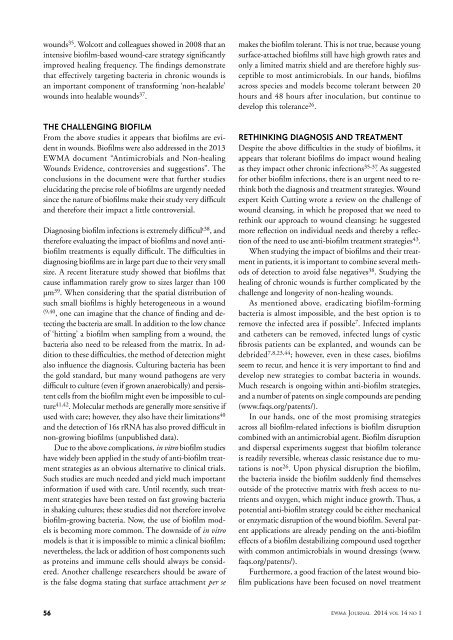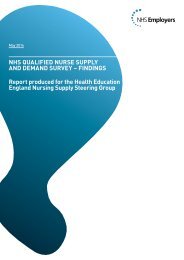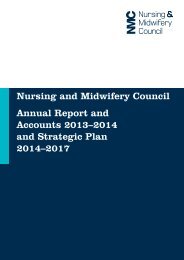Journal_1_2014_final_WEB
Journal_1_2014_final_WEB
Journal_1_2014_final_WEB
Create successful ePaper yourself
Turn your PDF publications into a flip-book with our unique Google optimized e-Paper software.
wounds 35 . Wolcott and colleagues showed in 2008 that an<br />
intensive biofilm-based wound-care strategy significantly<br />
improved healing frequency. The findings demonstrate<br />
that effectively targeting bacteria in chronic wounds is<br />
an important component of transforming ‘non-healable’<br />
wounds into healable wounds 37 .<br />
The challenging biofilm<br />
From the above studies it appears that biofilms are evident<br />
in wounds. Biofilms were also addressed in the 2013<br />
EWMA document “Antimicrobials and Non-healing<br />
Wounds Evidence, controversies and suggestions”. The<br />
conclusions in the document were that further studies<br />
elucidating the precise role of biofilms are urgently needed<br />
since the nature of biofilms make their study very difficult<br />
and therefore their impact a little controversial.<br />
Diagnosing biofilm infections is extremely difficul t38 , and<br />
therefore evaluating the impact of biofilms and novel antibiofilm<br />
treatments is equally difficult. The difficulties in<br />
diagnosing biofilms are in large part due to their very small<br />
size. A recent literature study showed that biofilms that<br />
cause inflammation rarely grow to sizes larger than 100<br />
μm 39 . When considering that the spatial distribution of<br />
such small biofilms is highly heterogeneous in a wound<br />
(9,40 , one can imagine that the chance of finding and detecting<br />
the bacteria are small. In addition to the low chance<br />
of ‘hitting’ a biofilm when sampling from a wound, the<br />
bacteria also need to be released from the matrix. In addition<br />
to these difficulties, the method of detection might<br />
also influence the diagnosis. Culturing bacteria has been<br />
the gold standard, but many wound pathogens are very<br />
difficult to culture (even if grown anaerobically) and persistent<br />
cells from the biofilm might even be impossible to culture<br />
41,42 . Molecular methods are generally more sensitive if<br />
used with care; however, they also have their limitations 40<br />
and the detection of 16s rRNA has also proved difficult in<br />
non-growing biofilms (unpublished data).<br />
Due to the above complications, in vitro biofilm studies<br />
have widely been applied in the study of anti-biofilm treatment<br />
strategies as an obvious alternative to clinical trials.<br />
Such studies are much needed and yield much important<br />
information if used with care. Until recently, such treatment<br />
strategies have been tested on fast growing bacteria<br />
in shaking cultures; these studies did not therefore involve<br />
biofilm-growing bacteria. Now, the use of biofilm models<br />
is becoming more common. The downside of in vitro<br />
models is that it is impossible to mimic a clinical biofilm;<br />
nevertheless, the lack or addition of host components such<br />
as proteins and immune cells should always be considered.<br />
Another challenge researchers should be aware of<br />
is the false dogma stating that surface attachment per se<br />
makes the biofilm tolerant. This is not true, because young<br />
surface-attached biofilms still have high growth rates and<br />
only a limited matrix shield and are therefore highly susceptible<br />
to most antimicrobials. In our hands, biofilms<br />
across species and models become tolerant between 20<br />
hours and 48 hours after inoculation, but continue to<br />
develop this tolerance 26 .<br />
Rethinking diagnosis and treatment<br />
Despite the above difficulties in the study of biofilms, it<br />
appears that tolerant biofilms do impact wound healing<br />
as they impact other chronic infections 35-37 . As suggested<br />
for other biofilm infections, there is an urgent need to rethink<br />
both the diagnosis and treatment strategies. Wound<br />
expert Keith Cutting wrote a review on the challenge of<br />
wound cleansing, in which he proposed that we need to<br />
rethink our approach to wound cleansing: he suggested<br />
more reflection on individual needs and thereby a reflection<br />
of the need to use anti-biofilm treatment strategies 43 .<br />
When studying the impact of biofilms and their treatment<br />
in patients, it is important to combine several methods<br />
of detection to avoid false negatives 38 . Studying the<br />
healing of chronic wounds is further complicated by the<br />
challenge and longevity of non-healing wounds.<br />
As mentioned above, eradicating biofilm-forming<br />
bacteria is almost impossible, and the best option is to<br />
remove the infected area if possible 7 . Infected implants<br />
and catheters can be removed, infected lungs of cystic<br />
fibrosis patients can be explanted, and wounds can be<br />
debrided 7,8,23,44 ; however, even in these cases, biofilms<br />
seem to recur, and hence it is very important to find and<br />
develop new strategies to combat bacteria in wounds.<br />
Much research is ongoing within anti-biofilm strategies,<br />
and a number of patents on single compounds are pending<br />
(www.faqs.org/patents/).<br />
In our hands, one of the most promising strategies<br />
across all biofilm-related infections is biofilm disruption<br />
combined with an antimicrobial agent. Biofilm disruption<br />
and dispersal experiments suggest that biofilm tolerance<br />
is readily reversible, whereas classic resistance due to mutations<br />
is not 26 . Upon physical disruption the biofilm,<br />
the bacteria inside the biofilm suddenly find themselves<br />
outside of the protective matrix with fresh access to nutrients<br />
and oxygen, which might induce growth. Thus, a<br />
potential anti-biofilm strategy could be either mechanical<br />
or enzymatic disruption of the wound biofilm. Several patent<br />
applications are already pending on the anti-biofilm<br />
effects of a biofilm destabilizing compound used together<br />
with common antimicrobials in wound dressings (www.<br />
faqs.org/patents/).<br />
Furthermore, a good fraction of the latest wound biofilm<br />
publications have been focused on novel treatment<br />
56<br />
EWMA <strong>Journal</strong> <strong>2014</strong> vol 14 no 1




